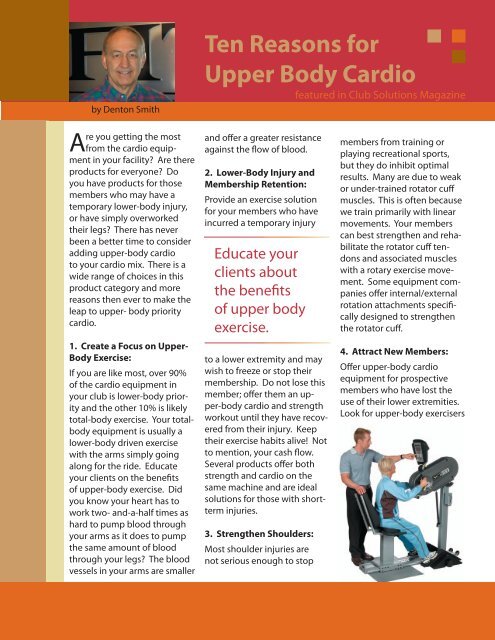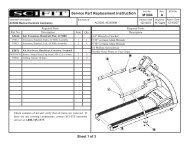Top 10 Reasons Upper Body.indd - SciFit
Top 10 Reasons Upper Body.indd - SciFit
Top 10 Reasons Upper Body.indd - SciFit
You also want an ePaper? Increase the reach of your titles
YUMPU automatically turns print PDFs into web optimized ePapers that Google loves.
y Denton Smith<br />
Are you getting the most<br />
from the cardio equipment<br />
in your facility? Are there<br />
products for everyone? Do<br />
you have products for those<br />
members who may have a<br />
temporary lower-body injury,<br />
or have simply overworked<br />
their legs? There has never<br />
been a better time to consider<br />
adding upper-body cardio<br />
to your cardio mix. There is a<br />
wide range of choices in this<br />
product category and more<br />
reasons then ever to make the<br />
leap to upper- body priority<br />
cardio.<br />
1. Create a Focus on <strong>Upper</strong>-<br />
<strong>Body</strong> Exercise:<br />
If you are like most, over 90%<br />
of the cardio equipment in<br />
your club is lower-body priority<br />
and the other <strong>10</strong>% is likely<br />
total-body exercise. Your totalbody<br />
equipment is usually a<br />
lower-body driven exercise<br />
with the arms simply going<br />
along for the ride. Educate<br />
your clients on the benefits<br />
of upper-body exercise. Did<br />
you know your heart has to<br />
work two- and-a-half times as<br />
hard to pump blood through<br />
your arms as it does to pump<br />
the same amount of blood<br />
through your legs? The blood<br />
vessels in your arms are smaller<br />
Ten <strong>Reasons</strong> for<br />
<strong>Upper</strong> <strong>Body</strong> Cardio<br />
and offer a greater resistance<br />
against the flow of blood.<br />
2. Lower-<strong>Body</strong> Injury and<br />
Membership Retention:<br />
Provide an exercise solution<br />
for your members who have<br />
incurred a temporary injury<br />
Educate your<br />
clients about<br />
the benefits<br />
of upper body<br />
exercise.<br />
to a lower extremity and may<br />
wish to freeze or stop their<br />
membership. Do not lose this<br />
member; offer them an upper-body<br />
cardio and strength<br />
workout until they have recovered<br />
from their injury. Keep<br />
their exercise habits alive! Not<br />
to mention, your cash flow.<br />
Several products offer both<br />
strength and cardio on the<br />
same machine and are ideal<br />
solutions for those with shortterm<br />
injuries.<br />
3. Strengthen Shoulders:<br />
Most shoulder injuries are<br />
not serious enough to stop<br />
featured in Club Solutions Magazine<br />
members from training or<br />
playing recreational sports,<br />
but they do inhibit optimal<br />
results. Many are due to weak<br />
or under-trained rotator cuff<br />
muscles. This is often because<br />
we train primarily with linear<br />
movements. Your members<br />
can best strengthen and rehabilitate<br />
the rotator cuff tendons<br />
and associated muscles<br />
with a rotary exercise movement.<br />
Some equipment companies<br />
offer internal/external<br />
rotation attachments specifically<br />
designed to strengthen<br />
the rotator cuff.<br />
4. Attract New Members:<br />
Offer upper-body cardio<br />
equipment for prospective<br />
members who have lost the<br />
use of their lower extremities.<br />
Look for upper-body exercisers
that offer swivel seats, for easy<br />
transfers, and with wheelchair<br />
platforms, for maximum ease<br />
of accessibility.<br />
5. Appeal to Cyclists and<br />
Runners:<br />
Many of your members ride a<br />
road bike, run, or jog for the<br />
majority of their lower-body<br />
conditioning. These members<br />
often fall victim to local leg fatigue<br />
and would gladly use an<br />
upper-body cycle for supplemental<br />
upper-body exercise.<br />
6. Keep Them Coming Back.<br />
How many members have you<br />
lost because they walked on<br />
a treadmill, but did not feel<br />
comfortable in your weight<br />
and machine area, and decided<br />
to walk at home? Using<br />
an upper-body cycle can help<br />
integrate them into other parts<br />
of your facility and would give<br />
them a reason to come back.<br />
7. Alternative Strength<br />
Training:<br />
An upper-body cardio machine<br />
with isokinetic resistance<br />
can provide primary strength<br />
training for the most deconditioned<br />
member and supplemental<br />
strength training for<br />
the strongest athlete. Strength<br />
training with Isokinetics is not<br />
intimidating and is safer for<br />
individuals new to strength<br />
training workouts.<br />
8. Cut Down on Treadmill<br />
Use:<br />
Dividing cardio time between<br />
upper body and lower body<br />
will significantly cut down on<br />
your treadmill usage. Remember,<br />
treadmills are the most<br />
expensive pieces of equipment<br />
in your facility, to both purchase<br />
and maintain.<br />
9. ADA Tax Credit:<br />
Many upper-body exercisers<br />
are wheelchair accessible and<br />
approved by the American’s<br />
with Disabilities Act (ADA).<br />
Take advantage of the ADA tax<br />
credit. If your facility qualifies,<br />
a 50% tax credit is available.<br />
That is a tax credit, not just a<br />
deduction.<br />
<strong>10</strong>. Cross Training:<br />
Cardiovascular cross training<br />
provides benefits that are<br />
not attainable from any other<br />
method of training. Focusing<br />
on upper-body only cardio for<br />
at least 1/3 of an individual’s<br />
workout is logical because the<br />
human muscular structure is<br />
approximately 1/3 upper body<br />
and 2/3 lower body. This blend<br />
of exercise is crucial to the balance<br />
of major muscle groups.<br />
<strong>Upper</strong>-body cycles are not just<br />
for people with lower-body<br />
injuries or disabilities. <strong>Upper</strong>-<br />
<strong>Upper</strong>-body cycles<br />
should be a part of<br />
every person’s cardio<br />
workout.<br />
body cycles should be a part of<br />
every person’s cardio workout.<br />
Simply stated, your cardio area<br />
should have a mix of at least<br />
15% upper-body only with<br />
another 15% all body. If your<br />
cardio area does not have this<br />
blend, your member retention<br />
rate may be significantly less<br />
than it should be, and your<br />
closing rate with the deconditioned<br />
members is also probably<br />
lower than it should be.<br />
Denton Smith is the President of<br />
SCIFIT Systems, Inc. He can be<br />
contacted at 800.278.3933, or by<br />
email at dsmith@scifit.com.
















